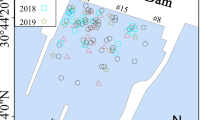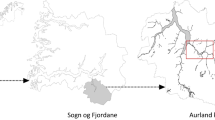Abstract
Since the construction of the Gezhouba Dam on the Yangtze River in 1981, it has been found that the Chinese Sturgeon, Acipensor sinensis, performs natural propagation annually in a narrow reach downstream close to the Gezhouba Dam site. This might allow one to better investigate the river hydrodynamic conditions of the Chinese Sturgeon spawning ground. In this article, spatial Kinetic Energy Gradient (KEG) and absolute value of vorticity were computed along the river sections from measured data. The relation between Spawn Density per Unit Area (SDUA) and vorticity strength and between SDUA and KEG were worked out. The Results showed that the vorticity and KEG were both effective parameters for describing the hydrodynamic characteristics of Chinese Sturgeon spawning ground. The Chinese Sturgeons prefer to spawn in the river sections where the value of vorticity strength is larger than 0.4 s−1 and KEG is larger than 0.029 Jkg−1m−1.
Similar content being viewed by others
References
YANG Zhi-feng, ZHANG Yuan. Comparison of methods for ecological and environmental flow in river channels [J]. Journal of Hydrodynamics, Ser. A, 2002, 18 (3): 294–301(in Chinese).
FU Xiao-li, LI Da-mei and JIN Guo-yu. Calculation of flow field and analysis of spawning sites for Chinese Sturgeon in the downstream of Gezhouba Dam [J]. Journal of Hydrodynamics, Ser. B, 2007, 19(1): 78–83.
WEI Qi-wei, BAN Xüan and LI Da-mei. Hydrological model of Chinese Sturgeon’s spawning site at lower reach of Gezhouba Hydroproject [J].Hubei Water Power, 2007, 68(2): 4–6(in Chinese).
YANG De-guo, WEI Qi-wei and CHEN Xi-hua et al. Hydrology status on the spawning ground of Acipenser sinens is below the Gezhouba Dam and its relation to the spawning run [J].Acta Ecologica Sinica, 2007, 27(3): 862–869.
ZHANG Hui, WEI Qi-wei and YANG De-guo et al. An observation on water current profiles of spawning of Acipenser sinensis downward Gezhouba Dam [J].Journal of Fishery Sciences of China, 2007, 14 (2): 183–191(in Chinese).
BARMUTA L. A. Interaction between the effects of substratun, velocity and location on stream Benthos: and experiment [J]. Australian Journal of Marine and Freshwater Research, 1990, 41(5): 557–657.
CHAMBERS P. A., PREPAS E. and HAMILTON H. R. et al. Current velocity and its effect on aquatic macrophytes in flowing waters [J]. Ecological Applications, 1991, 1(3): 249–257.
STATZNER B., GORE J. A. and RESH V. H. Hydraulic stream ecology: observed oatterns and potential applications [J]. Journal of the North American Benthological Society, 1988, 7(4): 307–360.
WETMORE S. H., MACKAY R. J. and NEWBURY R. W. Characterization of the hydraulic habitat of brachycentrus occidentalis, a filter-feeding caddisfly[J]. Journal of the North American Benthological Society, 1990, 9(2): 157–169.
HAYES J. W., JOWETT I. G. Microhabitat models of large drift-feeding brown trout in three New Zealand rivers [J]. North American Journal of Fisheries Management, 1994, 14(4): 710–725.
SHIELDS F. D. Jr, COOPER C. M. and KNIGHT Scott S. Experiment in stream restoration [J].Journal of Hydraulic Engineering,1995, 121(6): 494–502.
CROWER D. W. Reproducing and quantifying spatial flow patterns of ecological importance with two-dimensional hydraulic models [D]. Ph. D. Thesis, Blacksburg, USA: Virginia polytechnic Institute and state University, 2002.
YANG Yu, YAN Zhong-min and QIAO Ye. Descrption and review of hydaulics conditions of fish habitat [J]. Journal of Hohai University (Nature Science), 2007, 35(2): 125–130 (in Chinese).
YANG Yu, YAN Zhong-min and CHANG Jian-bo Assessing Chinese Sturgeon spawning ground by using acoustic Doppler current profiler to measure river velocities[C]. Int. Symp. on Flood Forecasting and Water Resources Assessment for IAHS-PUB 2005. Beijing, China, 2005, 432–439.
BARTOL I. K., GHARIB Morteza and WEIHS Daniel et al. Hydrodynamic stability of swimming in ostraciid fishes: role of the carapace in the smooth trunkfish Lactophrys triqueter (Teleostei: Ostraciidae) [J].J. Exp. Biol., 2003, 206(4):725–744.
YANG Yu, YAN Zhong-min and CHANG Jian-bo et al. Spawn ground hydraulic suitability of Chinese Sturgeon (Acipensor sinensis) from spatial kinetic energy gradient [C]. The 6th International Symposium on Ecohydraulics. Christchurch, New Zealand, 2007.
THE CHANGJIANG AQUATIC RESOURCES SURVEY GROUP, SICHUAN PROVINCE. The Biology of the Sturgeons in Changjiang and Their Artificial Propagation[B]. Chengdu: Sichuan Scientific and Technical Publishing House, 1998 (in Chinese).
Author information
Authors and Affiliations
Corresponding author
Additional information
Project supported by the National Natural Science Foundation of China (Grant No. 30490235), the NHRI Foundation for Youth (Grant No. Y10704).
Biography: YANG Yu (1976-), Male, Ph. D.
Rights and permissions
About this article
Cite this article
Yang, Y., Yang, Zm. & Chang, Jb. Hydrodynamic Characteristics of Chinese Sturgeon Spawning Ground in Yangtze River. J Hydrodyn 20, 225–230 (2008). https://doi.org/10.1016/S1001-6058(08)60050-5
Received:
Revised:
Published:
Issue Date:
DOI: https://doi.org/10.1016/S1001-6058(08)60050-5




